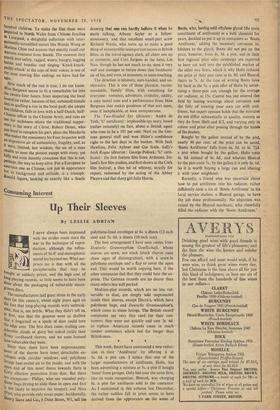PANEM 4 ET Pity the Romans didn't have television. They
liked their entertainment lavish and they liked it lurid. Yet it took more than gladiators to make a Roman holiday. With an exquisite taste for the finer things of life, the plebs demanded bread as well as circuses. Rome has spoken. Vox populi is the vox of breadagogues everywhere.
Patricians in the know about nutrition applaud the role that bread plays in the average diet. They say that bread and flour provide more energy, more protein, more iron and more of the two impor- tant vitamins B, and nicotinic acid, than any other single food.* With a performance like this, bread certainly deserves star billing on the family menu. In pane veritas. The only plebeian thing about bread is its price. Although bread is the cheapest basic food you can get, it is also the best, in terms of food value per penny. So see your family cats plenty of good fresh bread every day.
*National Food Survey Committee Report, 436 (Page 134 published by H.M.S.°. In 106, bread and flour provided, in the average diet, 24.7% of the energy; 263% of the protein; 269% of the Vitamin RI; 24.2% of the mcotintc acid; 23% of the Iron.
Note:—All flour contains—per too grams of flour: Vitamin L1,—not less than 0.24 milligrams. Nicotinic Acid—notless than 1• 6o milligrams. Iron—not less than I. 6s milligrams.
ISSUED BY THE FLOUR ADVISORY BUREAU, 31 ARLINGTON STREET, LONDON, S.W.I
whole of any experience she might be having at that moment. On the other hand, the flash- backs were scenes from her earlier life : they would come suddenly, while she was fully aware of her actual surroundings.
One example she gave was : without any warn- ing she had the experience of sitting in the rail- road station of a small town—It is winter and the wind is blowing outside, and I am waiting for a train.' This was certainly a short sequence from her earlier life, but it was one she had 'for- gotten.' These seizures were in fact minor attacks of epilepsy, of three types : (1) a sense of false familiarity (dija vu), (2) a feeling of fear, and (3) reproductions of previous experience. The first was an illusion, the second an emotion and the third an hallucination; all can be con- sidered as mental or 'psychical' phenomena.
At operation, part of the skull was lifted, under local anaesthesia; an area of wasting was noticed in the temporal area of the brain on one side. An EEG recording, taken directly from brain tissue, showed abnormal waves from that area. Stimulation by an electrode carrying a small current was then applied to various points in this region. As a rule, the patient was warned by the operator each time the electrode was applied; now and again, the warning was given with no stimulus or else the stimulus given without warn- ing—this procedure served to eliminate false or imaginary responses. When the electrode touched one point in the temporal zone, the patient said, 'I heard something familiar. I don't know what it was.' To the same stimulus again, she said, `Yes, sir. I think I heard a mother calling her little boy somewhere. It seemed to be something that happened years ago.' When asked to explain, she said, 'It was somebody in the neighbourhood where I live—somewhere close enough to hear. When the stimulus was given a third time---1/0, I hear the same familiar sounds, it seems to be a woman calling, the same lady. That was not in the neighbourhood. It seemed to be at the lumber yard.' Then she added reflectively, `r e never been around the lumber yard much.'
Here, then, was an incident of childhood which she could never have recalled without the aid of the stimulating electrode, and in fact she could not 'remember' it, but she knew at once that she must have experienced it at some time in the past. A little later,,stimulation at an adjacent point prompted her to say, 'I hear voices. It is late at night, around the carnival somewhere some sort of travelling circus. I saw lots of b wagons they use to haul animals in.' These r enacted scenes had elements of sight and of sour in them. As well as these flash-backs, the patiei had described feelings of fear and of familiarit ushering in the seizures; the second of thes though not the first, could be produced b stimulation of brain tissue.
These illusional alterations in the patient awareness, as Dr. Penfield says, are like sigma that flash up in consciousness, saying : this 5%' perience is familiar, it is fearful, things are approaching, or they are going away. The signals are simple 'feelings' that may be the same, though the experiences are always different. In normal living we depend on these 'interpretative' feelings the comparison of present experience wit similar past experience is automatic and uncor scious, but it is essential to rational and purposiv behaviour. O
0
OWOW030E0DOEOXE OWO#ODOEO#030E030E O O Your friends overseas who share For people
your tastes can share, too, your
privileged Guardian's-Eye-View you like— 0
For people
of the world — if you give them
a gift subscription to the like you...
Manchester Guardian Weekly.
witatmoi TO MAKE A LIFE LONG
FRIEND o*fft,1































































 Previous page
Previous page